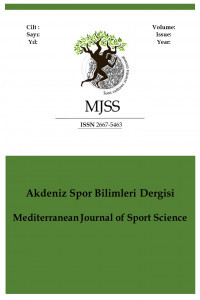Üniversite Öğrencilerinin Sağlıklı Olma Kültürü Davranışlarının Araştırılması
Sağlıklı Olma Kültürü, Fiziksel Aktivite, Obezite
A Study on The Examination of University Students' Cultures Of Being Healthy
Healthism, Physical Activity, Obesity,
___
- Aksoy,T., & Uçar. H. (2014). Healthy lifestyle behaviors of nursing students. Hacettepe University Journal of Nursing Faculty, 1(2), 53-67.
- Alfrey, L., O’Connor, J., Phillipson, S., Penney, D., Jeanes, R., & Phillipson, S. (2019). Attitudes of pre-service physical education teachers to healthism: Development and validation of the Attitude Towards Healthism Scale (ATHS). European Physical Education Review, 25(2), 424-437.
- Bozhüyük, A., Özcan, S., Kurdak, H., Akpınar, E., Saatçı, E., & Bozdemir, N. (2012). Healthy lifestyle and family medicine. Turkish Journal of Family Medicine and Primary Care, 6(1).
- Cihangiroğlu, Z., & Deveci, S. E. (2011). Healthy lifestyle behaviors and influencing factors of Fırat University Elâzığ School of Health students. Fırat Medical Journal, 16(2), 78-83.
- Cusumano, D. L., & Thompson, J. K. (1997). Body image and body shape ideals in journals: Expation, Awareness, and Internalization. Gender Roles, 37(9), 701-721.
- Dağdevire, Z., & Şimşek, Z. (2013). Health promotion behaviors of high school students in Şanlıurfa city center and related factors. TAF Preventive Medicine Bulletin, 12(2), 135-142.
- Kargün, M., Togo, O. T., Biner, M., & Adem, P. (2016). Examination of physical activity levels of university students. Marmara University Journal of Sports Sciences, 1(1), 61-72.
- Kavas A. (2003). Proper nutrition for a healthy life (3rd Edition). İstanbul: Literature Publishing, 6-15
- Kaya, F., Ünüvar, R., Bıçak, A., Yorgancı, E., Öz, B., & Kankaya, F. C. (2008). Examination of health promotion behaviors of instructors and influencing factors. TAF Preventive Medicine Bulletin, 7(1), 59-64.
- Kong, R. (1995). Building community capacity for health promotion: a challange for public health nurses. Public Health Nursing, 12(5), 312-8
- Kurtdaş, M. Ç. (2016). New forms of consumption shaped around the slogan of "healthy living". Sociological Thinking, 1(1), 1-10.
- Öztürk, Y. E., & Kıraç, R. (2019). Health and disease. Scientific Developments, 382.
- Pasinlioğlu, T., & Gözüm, S. (1998). Health behaviors of health personnel working in primary health care services. Cumhuriyet University Journal of School of Nursing, 2, 60-68.
- TUİK. (2021). Regional Results of Income and Living Conditions Survey, Issue: 45582. WHO/ILO joint estimates of the work-related burden of disease and injury, 2000-2016: global monitoring report: Geneva: World Health Organization and the International Labour Organization, 2021.
- Uğraş, S., Özen, G., Aykora, E., & Yurdakul, H. (2021). Adaptation of the healthism attitude scale to turkey: A validity and reliability study. Human Sport Medicine, 21(1), 117–123.
- Yayın Aralığı: Yılda 4 Sayı
- Başlangıç: 2018
- Yayıncı: Hasan ŞAHAN
Tip 1 Diyabetli Bireylerde Kombine Egzersizlerin Glisemik Kontrol Üzerine Etkisinin İncelenmesi
Tamer CİVİL, Nevin GÜNDÜZ, Mitat KOZ, Hüseyin DEMİRBİLEK
Egzersizin Spor Farkındalığı ve Mental Dayanıklılığa Etkisi
Yunus Emre ÇİNGÖZ, Mehmet SÖYLER
Gönül TEKKURŞUN DEMİR, Halil İbrahim CİCİOĞLU, Yunus Emre YARAYAN
Üniversite Öğrencilerinin Sağlıklı Olma Kültürü Davranışlarının Araştırılması
Murat Bekleyiş APAYDIN, Mustafa KIZILKOCA
Sporcuların Sosyal Zeka Düzeylerinin Karar Verme Üzerine Etkisi
Vücut Geliştirme Sporcularında Bigoreksiya ve Özgüven İlişkisi
Gençlik ve Spor İl Müdürlüğü Personelinin Örgütsel Bağlılıklarının İş Doyumuna Etkisi
Doğukan Batur Alp GÜLŞEN, Yeşim BAYRAKDAROĞLU, Yavuz ÖNTÜRK, Mustafa AYHAN, Mahir KAPLAN
